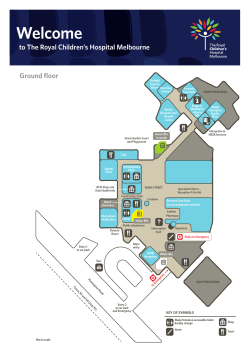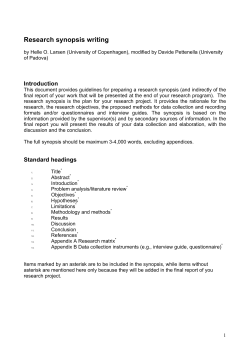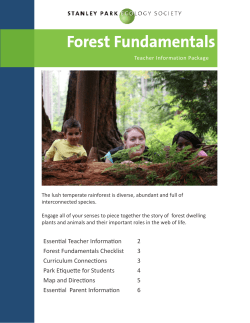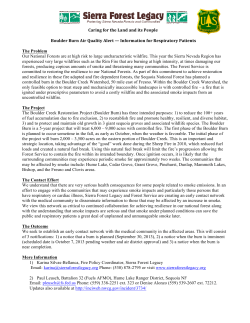
Document 98057
United States Department of Agriculture Forest Service Northeastern Forest Experiment Station Research Note NE-321 Sampling Land Use Edge from ~ e 6 a photographs I Line Transect vs. Circular Pattern - Robert T. Brooks and Karen J. Sykes Abstract Compares the diagonal line-transect and circular pattern for sampling land use edge. There were no significant differences in sampling efficiency. Methods Introduction In response to the Resources Planning Act (P.L. 93-378)and subsequent amending legislation, the Forest lnventory and Analysis unit of the Northeastern Forest Experiment Station is investigating techniques for the assessment of nontimber forestland resources. Our assessment of wildlife habitat quality includes the use of methods to survey landscape pattern, and the distance between different land use types. Landscape patterns are partially defined by land use edge which occurs where two differing land uses or vegetative communities abut. By monitoring the occurrence, or frequency, of various types of edge, we can describe changing landscape patterns. These data then can be interpreted for potential impacts on wildlife habitat conditions. The distance between various land uses or habitats is a second component of habitat quality for wildlife species that depend on or are sensitive to the resources unique to two or more land uses or habitats (Hays et al. 1381). An example is the distance from a potential white-tailed deer (Odocoileus virginianus) winter concentration area (Armstrong et al. 1983)to adjacent land uses such as residences. The close proximity of a residence could easily negate the value of the otherwise quality habitat condition. These two components of wildlife habitat quality, edge and distance, are easily identified and measured on aerial photographs (Schuerholtz 1974, Brooks and Scott 1983,McCall 1979). The Forest lnventory and Analysis unit has developed and implemented a procedure to sample land use edge (Barnes 1979,Barnes and Barnard 1979,Brooks and Scott 1983).A pattern of diagonal line-transects (Fig. 1) drafted on clear acetate is overlaid on an aerial photograph and edge occurrence is tallied where it is crossed by the transects. This procedure is an application of line-intersect sampling, and procedures have been developed for analyzing these data (Brooks and Scott 1983). To obtain information on distances between different land use types, we drafted a second sampling pattern, a set of four concentric circles (Fig. 1).We felt that the circular pattern could be used not only to measure distance but also to tally edge. We compared both patterns for sampling land use edge. Both the diagonal line-transect and the circular patterns were used to sample edge occurrence at Forest lnventory locations on 36 aerial photographs. These photos were selected randomly from 1975 photo coverage used in Piscataquis County, Maine, during the third forest resurvey of Maine. Forest lnventory currently identifies land use edge classes defined by the juxtaposition of four land uses or the occurrence of four linear land covers (Table 1). Land use edge was mapped on circular plots centered at points on aerial photos that were previously chosen and marked for the forest survey (Barnard 1978).Mapping is not usually done for production, however, for this test it guaranteed that both patterns sampled the identical edge population. To count edge with the diagonal transect, a transparency of the pattern is positioned on the aerial photo at the forest survey plot center. Edge hits, that is the intersection of any edge classes by a transect line, are counted and recorded (Fig. 2). of plot perimeter Vertical control line \ Figure 1.-Diagonal (left) and circular (right) transect pattern for sampling land use edge from aerial photographs. The vertical control line (VCL) on t h e circular pattern is used as a starting point. Table 1.-Descriptions of land use and linear land cover classes used to define land use edge Land use class Description Forest Land predominantly covered by woody-stemmed vegetation, on the average more than 25 feet tall, or over 70 percent crown closure if less than 25 feet tall (see Shrub). Type, age, and stocking characteristics are used to define forest-forest edges. Must be greater than 1 acre and wider than 120 feet if linear (see Hedgerow). Shrub Land predominantly covered by woody-stemmed vegetation less than 25 feet tall and 70 percent canopy closure. Must be greater than 1 acre and 120 feet wide if linear (see Hedgerow). Agricultural1 herbaceous Land predominantly covered by herbaceous vegetation, both cultivated and natural. Must be greater than 1 acre and 120 feet wide if linear. Cultural Land predominantly covered with human development including associated vegetation (e.g., lawns). Hedgerow Linear land cover, predominantly woody-stemmed vegetation and defined as being less than 120 feet wide. Transportation Vegetation associated with improved and maintained roads and railroads. rights-of-way Utility rights-of-way Vegetation associated with pipeline and electric transmission lines, tallied only i f land cover differs from adjacent land cover class. Aquatic Unique and distinguishable vegetation bordering streams, rivers, ponds, and lakes. Hardwood forest A\( lanes Ever Cornfields Edge of plot perimeter ( Hardwood forest I I Edc To survey edge with the circular transect, a transparency of the pattern was placed on the aerial photo at the plot center. A vertical control line is provided as an arbitrary starting place for each of the four circles. Beginning at the control line, edge hits for each edge classes were counted along all four circles and recorded (Fig. 2). For this test, actual edge length on each photo plot was measured by edge class using the Hewlett Packard 9830A graphics system.' An analysis of the effectiveness of each pattern was made using the general linear model: where: yi = edge length in mm for edge type class i, xi = edge hits by either diagonal or circular transects for edge class i, boi = intercept of the regression line for edge class, and bli = regression coefficient for edge class i. ,Hardwood The reduction in mean square error and the coefficient of determination were compared to evaluate the two patterns. Total edge length and the five major edge classes occurring on the 36 photo plots were examined. forest Shrub field Evergreen forest \ Edge of plot perimetery/'\ / Hardwood forest 1 Figure 2.-Comparative application and resultant edge hits by transect pattern for a hypothetical land use map. 'The use of trade, firm, or corporation names in this publication Is for the information and convenience of the reader. Such use does not constitute an official endorsement or approval by the US. D e partment of Agriculture or the Forest Service of any product or service to the exclusion of others that may be suitable. Results The circular photo plot has a radius of 20.1 mm and an area of 1,269.2 mm2 (Table 2). This plot on 1:40000 scale photography converts to an effective ground plot with a radius of 805 m (0.5 miles) and an area of 203.5 ha. Each of the four circles of the circular pattern was drafted to sample with an equal effort of 0.222 mmlmmz(Table 2). The total transect length for the two patterns is similar but not identical, consequently the sampling effort differs by pattern (Table 2). To compensate for this difference, the mean-squareerror statistic for the diagonal pattern was corrected for comparison t o the circular pattern's statistic (Table 3). Pattern comparisons are made for total edge length and for the forest-forest, forest-shrub, forestagriculturallherbaceous, transportation right-of-way, and aquatic edge classes. All of the regressions are significant as indicated by the F-statistic (Table 2). The coefficient of determination (R2) and the mean-squareerror statistics are equivalent for both patterns and each edge class comparison. Differences are minor and favor neither pattern. R-square values are larger for the circular pattern, except for the transportation right-ofway edge type (Table 3). The meansquare-error term is smaller using the circular pattern for the forest-shrub, forest-agriculturallherbaceous and aquatic edge types, but smaller using the diagonal pattern for the total edge, forest-forest, and transportation right-of-way comparisons. Table 2.-Aerial-photoplot and line-transect dimensions for comparison of diagonal and circular patterns for sampling land use edge Transect pattern Sampled area (photo) Diagonal Circular (total) Circle l (inner) Circle 2 Circle 3 Circle 4 (outer) Transect length Sample effort mm2 mm mm/mm2 1,269.2 1,269.2 127.2 254.2 381.4 508.5 243.0 282.7 28.3 56.5 84.8 113.1 0.191 ,223 .222 .222 .222 .222 Table 3.-Sample and regression statistics from the comparison of diagonal and circular patterns for sampling land use edge from aerial photographs Edge classesa edge forest Shrub Forestagricultural1 cultural herbaceous Shrub Agricultural1 Right-otway Aquatic agriculturall herbaceous Hedgerow Transportation herbaceous cultural Number of photos where edge observed Total edge length Photo plot (mm) Effective ground plot (km) Edge hits Diagonal transects Circular transects Regression statistics Diagonal R2 Fb Mean-square-errorc Circular R2 F Mean-square-error ashrub-cultural and Utility right-of-waywere not observed. bAll F-statistics are significant at alpha less than 0.01 level. CDiagonal mean-square-error term corrected by multiplication by the rate: (total diagonal transect length)= = 0.739 (total circular transect length) I No Analysis performed Discussion Literature Cited Neither pattern is clearly superior for surveying edge. The regression statistics are comparable for both patterns for total edge and for each of the five major edge classes. The relationships described by the regression models account for better than 85 percent of the variation in each analysis (Table 3). From the regression results alone, the choice of the most appropriate procedure to sample edge is uncertain. Therefore, the choice of the appropriate pattern is left to other criteria. The authors noted that: Armstrong, Edward; Euler David; Racey, Gerald. White-tailed deer habitat and cottage development in central Ontario. Journal of Wildlife Management, 47:605-612; 1983. 1. The circular pattern fails to sample edge conditions at the periphery of the photo plot, whereas the diagonal pattern extends to the outer circumference of the plot (Fig. 2). Barnes, Robert B. Wildlife habitat from a forest resources inventory: is it possible? Transaction Northeast Section, The Wildlife Society. 36:151-159; 1979. Schuerholtz, G. Quantitative evaluation of edge from aerial photographs. Journal of Wildlife Management. 381913-920; 1974. 2. The circular pattern is applied more efficiently because the circles are easier to follow. Barnes, Robert B.; Barnard, Joseph E. A wildlife habitat survey as part of a multiresource evaluation procedure. In Frayer, W. E. Forest Resource Inventories, Vol. I. Fort Collins, CO: Colorado State University; 1979: 77-89. Robert T. Brooks is a research wildlife biologist and Karen J,Sykes is a forester, Northeastern Forest Experiment Station, Broomall, Pennsylvania. Forest Inventory and Analysis has elected to use the circular pattern because it can also be used to estimate distance values as well as sample edge occurrence. The double application eliminates the need to carry and apply two sampling templates. Additionally, the circular pattern is more readily applied which is an important feature for production use. Barnard, Joseph E. Example of a speclflc reglonal Inventory: the United States Northeastern double sampllng wlth partial replacement de. sign. In: Proceedings, Joint Meeting of the International Union of Forestry Research Organizations Conference; June 18-26; Bucharest, Hungary. IUFRO; 1978: 620-628. Brooks, Robert T.; Scott, Charles T. Edge sampling techniques from aerial photographs. Wildlife Society Bulletin. 11:389-391; 1983. Hays, Robert L.; Summers, Cliff; Seitz, William. Estimating Wildlife Habitat Variables. FWSIOBS-81/47. Washington, DC: U.S. Department of Interior, Fish and Wildlife Service; 1981. 1 1 1 p. McCall, James D. The home-range scale: a tool for wildllfe hablfat assessment. Wildlife Society Bulletin. 7:118-120; 1979. Manuscript received for publication 4 October 1983 Circular transects are an appropriate method of surveying edge components of landscape patterns. The edge hit tally can be used directly as an index to edge occurrence. Estimates of on-the-ground edge lengths can be made using double-sampling and regression estimates (Brooks and Scott 1983). a U S . GOVERNMENT PRWTING OFFICE: 1984-705-0291519
© Copyright 2025





















